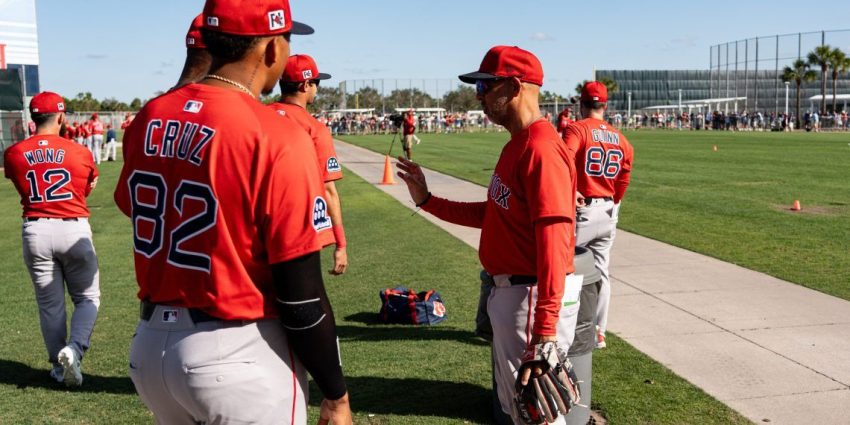Red Sox Shake Up Infield: Cora Moves Bregman to Third, Devers to DH in Strategic Shift
Boston Red Sox manager Alex Cora has made a bold lineup adjustment ahead of the 2025 MLB season, aiming to maximize the team’s strengths both offensively and defensively. In a move that signals a fresh tactical approach, Cora has announced that Alex Bregman will take over at third base, while longtime Red Sox star Rafael Devers will transition into the designated hitter role. This shift reflects a calculated strategy to enhance both the infield defense and the team’s overall offensive firepower, positioning Boston for a stronger season in a competitive American League East.
Cora’s Vision: A Strategic Realignment for Success
For weeks, speculation surrounded how the Red Sox would structure their infield following the acquisition of Alex Bregman. The veteran infielder, a two-time World Series champion with the Houston Astros, was a high-profile addition to the roster, bringing elite defensive skills and a consistent bat. With Bregman now slotted at third base, Cora is looking to capitalize on his defensive strengths while making adjustments that also serve to protect Rafael Devers’ longevity and maximize his offensive output.
By shifting Devers to the designated hitter role, the Red Sox are ensuring that one of their most potent bats remains a fixture in the lineup without the wear and tear of playing the field daily. The decision follows a broader trend in baseball, where teams aim to optimize their rosters by balancing defense and offense in a way that sustains productivity over a long season.
Bregman’s Impact: A Defensive Upgrade at Third
Bregman’s arrival in Boston gives the Red Sox a proven defender at third base, a position he has played at an elite level throughout his career. Known for his quick reflexes, strong throwing arm, and ability to make difficult plays look routine, Bregman provides a defensive upgrade at the hot corner. His addition not only solidifies the infield but also improves overall team defense, a key focus for Cora as the Red Sox seek to make a deeper postseason push.
Beyond his defensive capabilities, Bregman’s offensive production remains a valuable asset. A disciplined hitter with excellent on-base skills, he brings experience in high-pressure situations—something the Red Sox will rely on as they navigate a tough division. His ability to hit for power and make consistent contact adds another layer of depth to an already dangerous lineup.
Devers’ New Role: Maximizing Offensive Potential
While Rafael Devers has been the Red Sox’s primary third baseman for years, this transition to designated hitter is not a demotion but rather a strategic move aimed at sustaining his offensive dominance. Devers has been one of the most consistent power hitters in the league, and by focusing solely on hitting, he may be able to take his production to another level.
Playing DH will reduce the physical strain on Devers, allowing him to stay fresh throughout the season and minimize injury risks. This approach has worked successfully for other sluggers in the past, such as David Ortiz, who extended his career and remained a formidable presence in the lineup for years after stepping away from full-time defensive duties.
With Devers now concentrating on offense, the Red Sox are betting that he can increase his power numbers and maintain his ability to drive in runs consistently. His presence in the middle of the lineup will be crucial in providing protection for other key hitters and ensuring that Boston maintains a strong offensive presence against some of the toughest pitching staffs in baseball.
The Bigger Picture: Building a Championship-Caliber Roster
The Red Sox’s decision to restructure their infield isn’t just about immediate benefits—it’s about long-term sustainability and championship aspirations. By moving Bregman to third and Devers to DH, the team is building a lineup that balances defensive stability with offensive firepower.
Additionally, this move opens up opportunities for other players in the Red Sox system. With Devers no longer manning third base, younger infielders may get more chances to develop, particularly in backup or rotational roles. This could provide valuable depth as the season progresses and allow the team to maintain flexibility with matchups and lineup adjustments.
Furthermore, Cora’s decision underscores the importance of adaptability in modern baseball. Teams are increasingly willing to make unconventional moves if they believe it enhances overall team performance. This shift is an example of the Red Sox prioritizing both short-term success and long-term planning, ensuring that they remain competitive in a division that includes perennial powerhouses like the New York Yankees and Tampa Bay Rays.
Looking Ahead: How the Move Will Shape the Season
As the 2025 season gets underway, all eyes will be on how the new-look Red Sox lineup performs. Will Bregman’s defense and leadership elevate the team? Can Devers thrive in a full-time DH role and become an even more dominant hitter? These are questions that will be answered as the season unfolds.
Boston fans have seen Cora make bold moves before, and his track record suggests that he has a clear vision for how to maximize the talent on his roster. If this shift pays off, the Red Sox could find themselves in a prime position to contend for the playoffs and make a deep run in October.
One thing is certain—this move signals a commitment to winning, and with Bregman and Devers embracing their new roles, the Red Sox are positioning themselves for success in 2025 and beyond.
